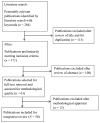An integrative review of factors associated with telomere length and implications for biobehavioral research
- PMID: 24335912
- PMCID: PMC4112289
- DOI: 10.1097/NNR.0000000000000009
An integrative review of factors associated with telomere length and implications for biobehavioral research
Abstract
Background: Although telomere shortening occurs as a natural part of aging, there is now a robust body of research that suggests that there is a relationship between psychosocial, environmental, and behavioral factors and changes in telomere length. These factors need to be considered when integrating telomere measurement in biobehavioral research studies.
Objectives: This article provides a brief summary of the known facts about telomere biology and an integrative review of current human research studies that assessed relationships between psychosocial, environmental, or behavioral factors and telomere length.
Methods: An integrative review was conducted to examine human research studies that focused on psychosocial, environmental, and behavioral factors affecting telomere length and telomerase activity using the electronic databases PubMed/Medline and CINAHL from 2003 to the present. In addition to the known individual factors that are associated with telomere length, the results of the integrative review suggest that perceived stress, childhood adversities, major depressive disorder, educational attainment, physical activity, and sleep duration should also be measured.
Discussion: Multiple factors have been shown to affect telomere length. To advance understanding of the role of telomere length in health and disease risk, it will be important to further elucidate the mechanisms that contribute to telomere shortening.
Conflict of interest statement
The authors have no conflicts of interest to disclose.
Figures



Similar articles
-
Stress and telomere biology: a lifespan perspective.Psychoneuroendocrinology. 2013 Sep;38(9):1835-42. doi: 10.1016/j.psyneuen.2013.03.010. Epub 2013 Apr 29. Psychoneuroendocrinology. 2013. PMID: 23639252 Free PMC article. Review.
-
Psychosocial Stressors and Telomere Length: A Current Review of the Science.Annu Rev Public Health. 2020 Apr 2;41:223-245. doi: 10.1146/annurev-publhealth-040119-094239. Epub 2020 Jan 3. Annu Rev Public Health. 2020. PMID: 31900099 Review.
-
Stress, Telomeres, and Psychopathology: Toward a Deeper Understanding of a Triad of Early Aging.Annu Rev Clin Psychol. 2018 May 7;14:371-397. doi: 10.1146/annurev-clinpsy-032816-045054. Epub 2018 Mar 1. Annu Rev Clin Psychol. 2018. PMID: 29494257 Free PMC article. Review.
-
Childhood maltreatment, behavioral adjustment, and molecular markers of cellular aging in preschool-aged children: A cohort study.Psychoneuroendocrinology. 2019 Sep;107:261-269. doi: 10.1016/j.psyneuen.2019.05.015. Epub 2019 May 15. Psychoneuroendocrinology. 2019. PMID: 31174164 Free PMC article.
-
Telomeres and early-life stress: an overview.Biol Psychiatry. 2013 Jan 1;73(1):15-23. doi: 10.1016/j.biopsych.2012.06.025. Epub 2012 Jul 24. Biol Psychiatry. 2013. PMID: 22831981 Free PMC article. Review.
Cited by
-
Telomere Length in a South African Population Co-Infected with HIV and Helminths.Curr Issues Mol Biol. 2024 Jul 2;46(7):6853-6867. doi: 10.3390/cimb46070409. Curr Issues Mol Biol. 2024. PMID: 39057051 Free PMC article.
-
Mechanisms of the Maternal Exposome and Implications for Health Outcomes.ANS Adv Nurs Sci. 2016 Apr-Jun;39(2):E17-30. doi: 10.1097/ANS.0000000000000110. ANS Adv Nurs Sci. 2016. PMID: 27149232 Free PMC article.
-
Where You Live May Make You Old: The Association between Perceived Poor Neighborhood Quality and Leukocyte Telomere Length.PLoS One. 2015 Jun 17;10(6):e0128460. doi: 10.1371/journal.pone.0128460. eCollection 2015. PLoS One. 2015. PMID: 26083263 Free PMC article.
-
The relationship between neighborhood socioeconomic deprivation and telomere length: The 1999-2002 National Health and Nutrition Examination Survey.SSM Popul Health. 2019 Nov 16;10:100517. doi: 10.1016/j.ssmph.2019.100517. eCollection 2020 Apr. SSM Popul Health. 2019. PMID: 31872036 Free PMC article.
-
Resilience factors may buffer cellular aging in individuals with and without chronic knee pain.Mol Pain. 2019 Jan-Dec;15:1744806919842962. doi: 10.1177/1744806919842962. Mol Pain. 2019. PMID: 30900507 Free PMC article.
References
Publication types
MeSH terms
Grants and funding
LinkOut - more resources
Full Text Sources
Other Literature Sources
Medical

